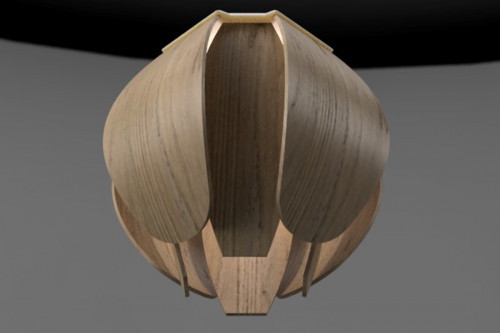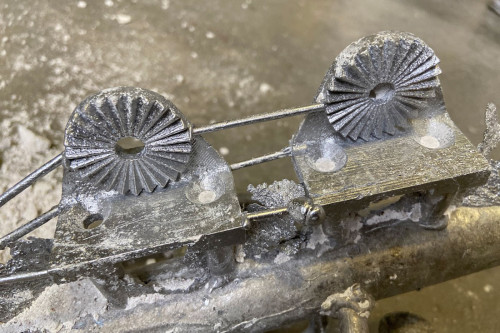Art Professor Creates Furnishings, Pet Wheelchair Components, Face Shields & More Using 3D Printers & Recycled Materials

 Brian Ferrell is an associate professor of art at Seton Hill University. He’s also an established artist, having made his name as a “creator of sculpturally functional furniture and hollowware.” Brian’s work varies in size from tableware to dining sets, and is part of many private collections in the U.S., U.K., Germany and Dubai. Brian has traditionally made use of materials such as carved wood, pewter, steel and stainless steel cable in his work. While setting up the new 3D printing space in Seton Hill’s Arts Center, he became interested in plastics. And that led him in a whole new direction.
Brian Ferrell is an associate professor of art at Seton Hill University. He’s also an established artist, having made his name as a “creator of sculpturally functional furniture and hollowware.” Brian’s work varies in size from tableware to dining sets, and is part of many private collections in the U.S., U.K., Germany and Dubai. Brian has traditionally made use of materials such as carved wood, pewter, steel and stainless steel cable in his work. While setting up the new 3D printing space in Seton Hill’s Arts Center, he became interested in plastics. And that led him in a whole new direction.
What was your inspiration for using recycled materials  in your work?
in your work?
It was a number of little things, from being skeptical of whether my weekly recycling is actually being recycled to just trying to avoid using grocery bags. As I started to develop the 3D printing space, I realized that most printed material is plastic. We have the ability to 3D print in a number of types of plastics but this can be wasteful, especially when prints fail. Because of this, I began to research how to make usable filament from print waste.
What kind of plastic do we use most often in the 3D printers at Seton Hill?
The type of plastic we use most often, PLA, is actually corn or beet-based so it is not from petroleum. Recycled PLA is good for prototyping, and can be used to make casting molds for ceramic or metal. Other plastics are difficult to print and require a lot of precision.
Can you describe some of your recent projects that use recycled materials?
I had some success printing with recycled polypropylene. This was in conjunction with a project I am working on with Reimagine Recycling, a nonprofit in Pittsburgh that collects used polypropylene and presses it into shelves and other home goods.
We are making a hanging light that will have recycled components. This is part of the Green Leap program through another local organization, Monmade.
"There are jobs in nearly every major that will have printers in the workplace. My 3D printing class is open to all students, and my hope is that I can provide them with unique 21st-century skills."
During the initial phase of the pandemic, I was developing our 3D printing space. With the new equipment sitting unused, I began looking for ways to volunteer. We printed a lot of face shields for the greater community.
I also reached out to DIVE, a firm that is rooted in Additive Manufacturing, to collaborate with their pet mobility brand 3D Pets. I have been working with them on ways to recycle their failed prints. This led to developing a method of pressing animal wheelchair hinges using recycled grocery bags.
We’re also working on a project where we use recycled aluminum to cast some other wheelchair components for the animal carts. We want to make an aluminum wheel with a tire made using the recycled plastic. These will be made in the Foundry in Seton Hill’s Arts Center.
Are Seton Hill students involved with any of these projects?
We are now offering a 3D printing course every fall. This course provides the technical knowledge to design and print. With this foundational information, students can explore more complicated processes. In Fall '22, I worked with an Art Education senior to design a fork and spoon. We printed press molds in resin, and she created them using recycled HDPE plastic. The piece was in her senior show.
Aside from artistic expression - and of course the sustainability aspect - what are the benefits to students of learning 3D printing techniques?
Right now additive manufacturing (3D printing) is a multi-billion dollar industry. Very few universities train for this type of career. There are jobs in nearly every major that will have printers in the workplace. My 3D printing class is open to all students, and my hope is that I can provide them with unique 21st-century skills.
How does your personal art inspire/inform your teaching at Seton Hill?
The work that I make comes from a place of function. I make a variety of furniture, tableware, and lighting objects. These pieces use a variety of materials, which requires a breadth of technical knowledge in order to manipulate these materials. The ceramic vessels I make are designed in CAD, printed, molded in plaster, and then cast in ceramic. I often combine traditional methods of making with cutting-edge technology.
Our art program is rooted in traditional methods of making. Metalsmithing, woodworking, ceramics, and foundry casting have been around for centuries. I like to think that I am giving the students the foundational knowledge to control materials and the technical knowledge to take their pieces to the next level. I hope the combination of these methods can give our students a diverse knowledge base for jobs that didn't exist just a few years ago.
Photos, above: Students in a 3D Design Lab (top); Brian Ferrell (left)





